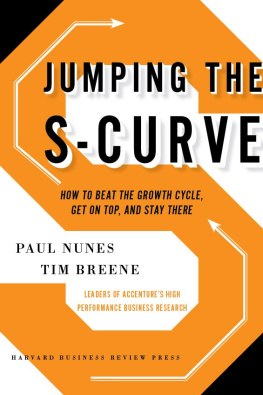Paul F. Nunes - Jumping the S-Curve: How to Beat the Growth Cycle, Get on Top, and Stay There
Here you can read online Paul F. Nunes - Jumping the S-Curve: How to Beat the Growth Cycle, Get on Top, and Stay There full text of the book (entire story) in english for free. Download pdf and epub, get meaning, cover and reviews about this ebook. year: 2011, publisher: Unspecified;Harvard Business Review Press, genre: Business. Description of the work, (preface) as well as reviews are available. Best literature library LitArk.com created for fans of good reading and offers a wide selection of genres:
Romance novel
Science fiction
Adventure
Detective
Science
History
Home and family
Prose
Art
Politics
Computer
Non-fiction
Religion
Business
Children
Humor
Choose a favorite category and find really read worthwhile books. Enjoy immersion in the world of imagination, feel the emotions of the characters or learn something new for yourself, make an fascinating discovery.
- Book:Jumping the S-Curve: How to Beat the Growth Cycle, Get on Top, and Stay There
- Author:
- Publisher:Unspecified;Harvard Business Review Press
- Genre:
- Year:2011
- Rating:4 / 5
- Favourites:Add to favourites
- Your mark:
- 80
- 1
- 2
- 3
- 4
- 5
Jumping the S-Curve: How to Beat the Growth Cycle, Get on Top, and Stay There: summary, description and annotation
We offer to read an annotation, description, summary or preface (depends on what the author of the book "Jumping the S-Curve: How to Beat the Growth Cycle, Get on Top, and Stay There" wrote himself). If you haven't found the necessary information about the book — write in the comments, we will try to find it.
Paul F. Nunes: author's other books
Who wrote Jumping the S-Curve: How to Beat the Growth Cycle, Get on Top, and Stay There? Find out the surname, the name of the author of the book and a list of all author's works by series.
Jumping the S-Curve: How to Beat the Growth Cycle, Get on Top, and Stay There — read online for free the complete book (whole text) full work
Below is the text of the book, divided by pages. System saving the place of the last page read, allows you to conveniently read the book "Jumping the S-Curve: How to Beat the Growth Cycle, Get on Top, and Stay There" online for free, without having to search again every time where you left off. Put a bookmark, and you can go to the page where you finished reading at any time.
Font size:
Interval:
Bookmark:
JUMPING THE
S - CURVE

Copyright Accenture 2011
All rights reserved
Printed in the United States of America
15 14 13 12 11 5 4 3 2 1
No part of this publication may be reproduced, stored in or introduced into a retrieval system, or transmitted, in any form, or by any means (electronic, mechanical, photocopying, recording, or otherwise), without the prior permission of the publisher. Requests for permission should be directed to , or mailed to Permissions, Harvard Business School Publishing, 60 Harvard Way, Boston, Massachusetts 02163.
Copyright 2011 Accenture. All rights reserved. Accenture, its logo, High Performance Delivered, and High Performance Business are trademarks of Accenture.
Library of Congress Cataloging-in-Publication Data
Nunes, Paul, 1963
Jumping the S-curve : how to beat the growth cycle, get on top, and stay there / Paul Nunes and Tim Breene.
p. cm.
Includes bibliographical references.
ISBN 978-1-4221-7558-3 (hbk. : alk. paper)
1. Organizational effectiveness. 2. Performance. 3. Strategic planning. 4. Success in business. I. Breene, Tim. II. Title.
HD58.9.N86 2011
658.4012dc22
2010031416
The paper used in this publication meets the requirements of the American National Standard for Permanence of Paper for Publications and Documents in Libraries and Archives Z39.48-1992.
CONTENTS
| HIGH PERFORMANCE: THE BUSINESS OF JUMPING S-CURVES |
F OR MANY DECADES , Zenith truly wasas its name suggestsat the top. Founded in 1918 and incorporated in 1923 as the Zenith Radio Corporation, the company introduced the worlds first portable radio in 1924. Two decades later, with the advent of television, the company successfully shifted its focus. It introduced its first black-and-white sets in 1948 and later developed the first hand-held remote control in 1956 and a new standard for color television, the Chromacolor tube, in 1969. Throughout this period, Zenith was known by the slogan it coined for itself back in 1927: The quality goes in before the name goes on.
But in the 1970s, the tide began to turn. Japanese manufacturers took an ever larger portion of U.S. television set sales, grabbing market share of 45 percent by 1976, triple its level at the beginning of the decade.
Zenith wasnt beaten yet, however. In the 1980s, it moved into the computer business with Zenith Data Systems (eventually selling out to the French company Groupe Bull for more than $600 million), even as its attempts to maintain a profitable television operation were likened to rearranging deck chairs on the Titanic by one publication.
It was at once too early and too late: well ahead with HDTV as a true consumer option, but too late to save its television business. The ship ultimately did go down, as longtime partner LG Electronics of South Korea acquired a 5 percent stake in 1991, which grew to 55 percent by 1995 when LG kicked in $350 million to gain control of the companyprincipally for its HDTV technology. Finally, in 1999, Zenith filed for bankruptcy and LG took over the remains.
Zenith exemplifies both the success of the high-performance business and the limits that many companies reach. It scaled the heights of success first with its radio business and then did what few companies are able to do: it made the leap to a second successful business when it moved into television. Ultimately, however, it couldnt replicate that success yet a third time, either with computers or with HDTV.
Zenith had become a great company, twice (and may become one yet again, as LG has recently resurrected the brand with some early success). But high performance isnt about achieving greatness, which is far too static a concept. It is about outperforming the competition again and again, even as the basis of competition in an industry or market changes. High-performance companies (or organizations) are those that continually repeat their success. They show the world that their first trip to the top was not an accident. These companies accomplish the difficult feat that gives rise to the title of this book: they jump the S-curve.
What exactly do we mean by S-curve ? The term is widely used for a variety of reasons (for more, see The Explanatory Power of the S-Curve). But when we use the term, we simply mean the common pattern in which a successful business starts small with a few eager customers, grows rapidly as the masses seek out the new offering, and eventually peaks and levels off as the market matures. And when we speak of high-performance companies (or organizations), we mean those that somehow manage to climb that S-curve and then jump to a new one again and again ().
The Explanatory Power of the S-Curve The use of the term S-curve in business circles goes back at least to the late 1800s, but it gained broader currency in the early 1960s, when Stanford University professor Everett Rogers published Diffusion of Innovations . In this book, Rogers shows how the cumulative sum of adopters of an innovation takes on the shape of the letter S . He then characterizes segments of adopters in terms that are still commonly used today. During the dot-com era, the meaning of the phenomenon was adapted to describe the rollout of the new Internet-related technologies. Best-selling books like Geoffrey Moores Crossing the Chasm explained how new-technology companies could break out of the bottom of the curve and reach the top. We have found that the term S-curve can be adapted yet again to explain business performance over time. Companies thrive, after all, by successfully delivering some form of innovation to customers. Performance starts slowly as the business is launched and the company experiments to find the right business formula. Then performance accelerates rapidly as word of the attractiveness of the offering spreads, and finally it fades as the market approaches saturation, imitators appear, and obsolescence leads to better substitutes. (See .)FIGURE 1-1
High performance: the climbing and jumping of S-curves

FIGURE 1-2
Diffusion of successful business offerings
After a successful new business offering is taken up by the early adopters, its rate of adoption grows rapidly before leveling off as it approaches the market saturation point .

Recognizing high performance as a series of climbs and jumps may sound intuitive, but it was not immediately obvious to us when we began our journey. A good deal of the literature on business performance at the time focused on providing a recipe for greatness In Search of Excellence , Good to Great , and Peak Performance are a just a few of the classics in that category. Other worksbooks like Built to Last , Creative Destruction , and What Really Works sought to unlock the secrets of company endurance. But a detailed, research-based analysis of the intersection of the twohow companies can achieve repeated peaks of high performancewas missing.
This was the gap that we sought to close as we took on responsibility for creating and leading the still ongoing program at Accenture to understand high performance in businessa program begun in 2003. In the near decade since, we have a learned a great deal about how companies achieve recurring greatnesswhich is our definition of high performance in a nutshell. For companies that want to achieve high performance, our lessons learned may sound counterintuitive: what matters most to long-term performance is not so much what you do to reach the topthough that is certainly importantbut what you do to cross over to the bottom of the next S-curve and begin the climb again. Similarly, the secret to successfully jumping the S-curve is not about what you do at or near the top of the curve, but what you do to prepare for the jump on the way up. The ability of some companies to move to the bottom of the next curve, even as they climb the original one, is the focus of this book.
Next pageFont size:
Interval:
Bookmark:
Similar books «Jumping the S-Curve: How to Beat the Growth Cycle, Get on Top, and Stay There»
Look at similar books to Jumping the S-Curve: How to Beat the Growth Cycle, Get on Top, and Stay There. We have selected literature similar in name and meaning in the hope of providing readers with more options to find new, interesting, not yet read works.
Discussion, reviews of the book Jumping the S-Curve: How to Beat the Growth Cycle, Get on Top, and Stay There and just readers' own opinions. Leave your comments, write what you think about the work, its meaning or the main characters. Specify what exactly you liked and what you didn't like, and why you think so.












